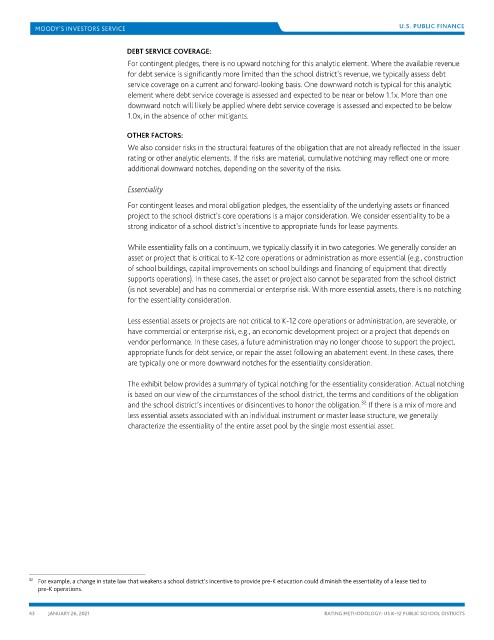Page 1683 - draft
P. 1683
U.S. PUBLIC FINANCE
DEBT SERVICE COVERAGE:
For contingent pledges, there is no upward notching for this analytic element. Where the available revenue
for debt service is significantly more limited than the school district’s revenue, we typically assess debt
service coverage on a current and forward-looking basis. One downward notch is typical for this analytic
element where debt service coverage is assessed and expected to be near or below 1.1x. More than one
downward notch will likely be applied where debt service coverage is assessed and expected to be below
1.0x, in the absence of other mitigants.
OTHER FACTORS:
We also consider risks in the structural features of the obligation that are not already reflected in the issuer
rating or other analytic elements. If the risks are material, cumulative notching may reflect one or more
additional downward notches, depending on the severity of the risks.
Essentiality
For contingent leases and moral obligation pledges, the essentiality of the underlying assets or financed
project to the school district’s core operations is a major consideration. We consider essentiality to be a
strong indicator of a school district’s incentive to appropriate funds for lease payments.
While essentiality falls on a continuum, we typically classify it in two categories. We generally consider an
asset or project that is critical to K-12 core operations or administration as more essential (e.g., construction
of school buildings, capital improvements on school buildings and financing of equipment that directly
supports operations). In these cases, the asset or project also cannot be separated from the school district
(is not severable) and has no commercial or enterprise risk. With more essential assets, there is no notching
for the essentiality consideration.
Less essential assets or projects are not critical to K-12 core operations or administration, are severable, or
have commercial or enterprise risk, e.g., an economic development project or a project that depends on
vendor performance. In these cases, a future administration may no longer choose to support the project,
appropriate funds for debt service, or repair the asset following an abatement event. In these cases, there
are typically one or more downward notches for the essentiality consideration.
The exhibit below provides a summary of typical notching for the essentiality consideration. Actual notching
is based on our view of the circumstances of the school district, the terms and conditions of the obligation
32
and the school district’s incentives or disincentives to honor the obligation. If there is a mix of more and
less essential assets associated with an individual instrument or master lease structure, we generally
characterize the essentiality of the entire asset pool by the single most essential asset.
32 For example, a change in state law that weakens a school district’s incentive to provide pre-K education could diminish the essentiality of a lease tied to
pre-K operations.
43 JANUARY 26, 2021 RATING METHODOLOGY: US K–12 PUBLIC SCHOOL DISTRICTS

